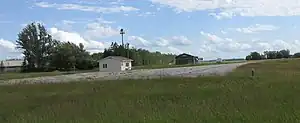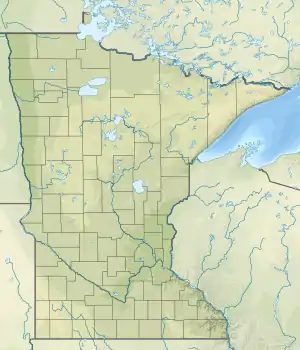Piney Pinecreek Border Airport
Piney Pinecreek Border Airport (ICAO: K48Y, FAA LID: 48Y, TC LID: K48Y)[1][2] is a public use general aviation airport located 2 nautical miles (3.7 km; 2.3 mi) northwest[1][2] of the central business district of Pinecreek, in Dieter Township, Roseau County, Minnesota, United States, on the Canada–US border. It is jointly owned by the Minnesota Department of Transportation and the government of Piney, Manitoba.[1] It is shared by the rural communities of Piney, Manitoba and Pinecreek, Minnesota.
 Ramp facilities at Piney Pinecreek Border Airport. The left-hand building and ramp is north of the border in Canada; the right-hand building and ramp is in the United States. | |||||||||||
| Summary | |||||||||||
| Airport type | Public | ||||||||||
| Owner | Minnesota DOT and government of Piney, Manitoba | ||||||||||
| Operator | Piney/Pinecreek Border Airport Commission | ||||||||||
| Serves | Piney, Manitoba[2] Pinecreek, Minnesota[1] | ||||||||||
| Location | Canada–United States border | ||||||||||
| Time zone | CST (UTC−06:00) | ||||||||||
| • Summer (DST) | CDT (UTC−05:00) | ||||||||||
| Elevation AMSL | 1,082 ft / 330 m | ||||||||||
| Coordinates | 48°59′56″N 095°58′56″W | ||||||||||
| Map | |||||||||||
 48Y Location in Minnesota/Manitoba  48Y 48Y (the United States) | |||||||||||
| Runways | |||||||||||
| |||||||||||
| Statistics (2008) | |||||||||||
| |||||||||||
Also known as Pinecreek/Piney Pinecreek Border Aerodrome,[2] it is one of six airports that cross the Canada–US border and the easternmost.[4] The other airports, east to west, are International Peace Garden Airport, Coronach/Scobey Border Station Airport, Coutts/Ross International Airport, Whetstone International Airport (Del Bonita/Whetstone International Airport), and Avey Field State Airport.
The airport, located at 48°59′56″N 095°58′56″W,[1][2] was originally located entirely within the United States. Needing to extend the runway, the owners found it could not be extended south due to a nearby road, but the land to the immediate north was unused. After arrangements were made with Canadian and Manitoba authorities, the runway was extended across the 49th parallel. The initial and extended runways were turf but have since been paved.
The airport, located in Manitoba and Minnesota, has both United States and Canada customs services and is attractive to tourists, hunters and fishermen. Ground access is available on Manitoba Highway 89 and Minnesota State Highway 89.
The airport is classified as an airport of entry by Nav Canada and is staffed by the Canada Border Services Agency (CBSA). CBSA officers at this airport can handle general aviation aircraft only, with no more than 15 passengers.[2]
History
An airport for the town of Pinecreek was proposed by resident Eugene Simmons in 1949, to expedite cross-border general aviation traffic. The airport initially opened on July 29, 1953, with a runway terminating just before the international border. To allow operation of larger aircraft, a 1150-foot extension was proposed in 1972. However, this had to cross the US-Canadian border and required extensive negotiation between local and national governments. The extended runway and bi-national airport was dedicated on July 28, 1978.[5]
Facilities and aircraft
Piney Pinecreek Border Airport covers an area of 61 acres (25 ha) at an elevation of 1,082 ft (330 m) above mean sea level.[1][2] It has one asphalt paved runway designated 15/33 which measures 3,297 by 75 ft (1,005 by 23 m).[1][2]
For the 12-month period ending May 31, 2011, the airport had 3,000 general aviation aircraft operations, an average of 250 per month.[1]
Two aprons allow passengers to deplane in either country and walk to the respective customs authority. Pilots and passengers in Canada need to walk across Provincial Trunk Route 89 to report to CBSA, while in the US, the border station is located on the airport side of Minnesota State Highway 89. Fuel tanks are located on the US side.
See also
References
- FAA Airport Form 5010 for 48Y PDF
- Canada Flight Supplement. Effective 0901Z 16 July 2020 to 0901Z 10 September 2020.
- Some US sources indicate CJX2 as the code. However, the CFS uses K48Y and as of the current edition there is no airport in Canada using CJX2
- "Chapter 5: The 49th Parallel". United Divide: A Linear Portrait of the USA/Canada Border. The Center for Land Use Interpretation. Winter 2015.
- Times, Andrew H. Malcolm Special to The New York (1979-06-28). "Border Airport Overcomes Gophers and Bureaucracies". The New York Times. ISSN 0362-4331. Retrieved 2023-02-09.
External links
- "Piney - Pinecreek Border Airport" (PDF). Archived from the original (PDF) on 2015-09-21. (209 KB) at Minnesota DOT Airport Directory
- Resources for this airport:
- FAA airport information for 48Y
- AirNav airport information for 48Y
- FlightAware airport information and live flight tracker
- SkyVector aeronautical chart for 48Y